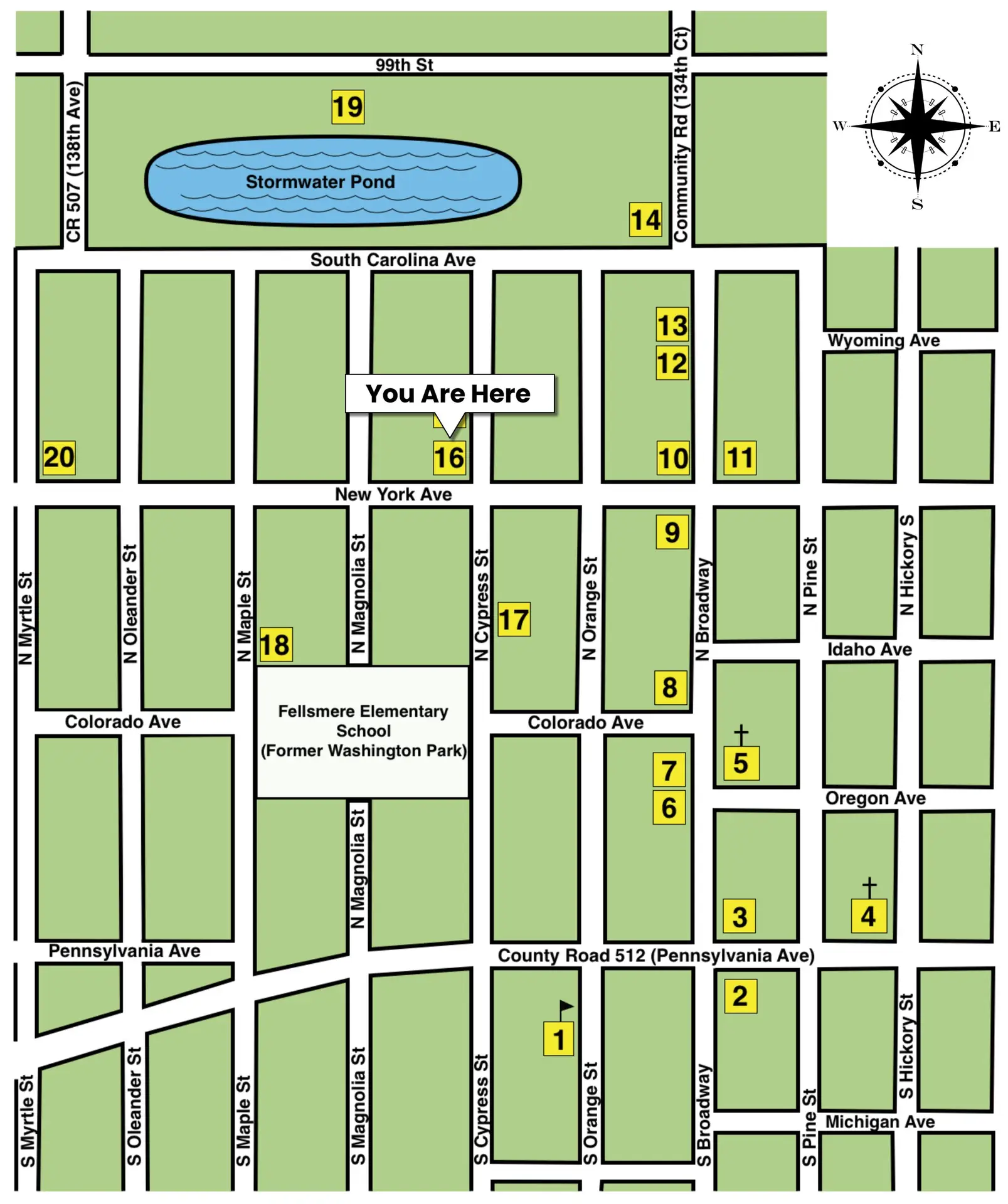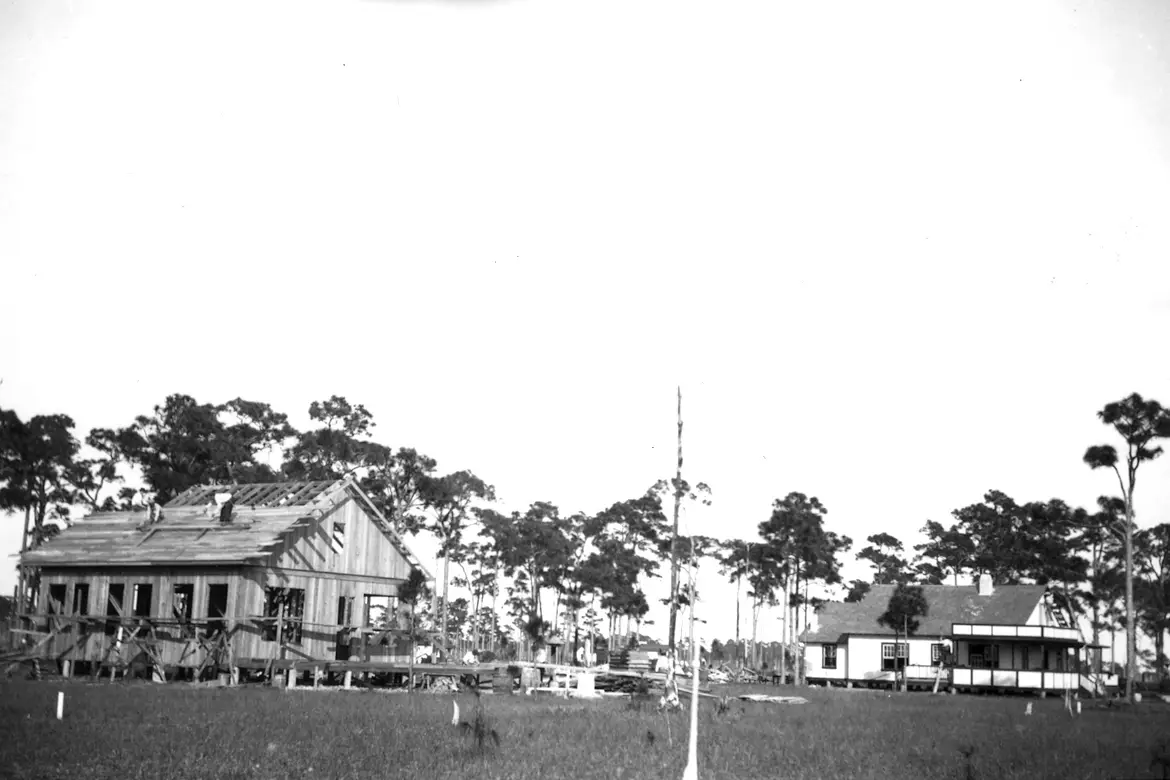The Irwin S. And Clara Lhoyd House History
The Fellsmere Farms Company was incorporated on May 25, 1910.1 The first order of business was to construct the Fellsmere Railroad from Sebastian to Fellsmere, in order to bring in all of the building materials, supplies, and labor needed to develop Fellsmere.2 Once the railroad was completed, the Fellsmere Farms Company focused on constructing the drainage system and developing the Town of Fellsmere.3 To oversee the drainage work and development of Fellsmere, the Fellsmere Farms Company hired Irwin S. Lhoyd as its Chief Engineer.4
Irwin Sigourney (I.S.) Lloyd was born on October 18, 1868, in Washington Heights on the Manhattan Island in New York City. Irwin S. Lhoyd’s father was William F. Lhoyd, an Episcopalian Clergyman, who was born in Dublin, Ireland and died in 1890 after living for 45 years in the United States.5 His mother, Ellen E. Sigourney, was born in Oxford, Massachusetts.6
Irwin S. Lhoyd was both a surveyor and a civil engineer. He graduated from Worcester Polytechnic Institute in Massachusetts in 1887.7 From 1888 to 1890, he worked as a surveyor for Hellman, Hough, and McClintock in West Los Angeles, California.8 During 1890, Lhoyd worked as a surveyor for John Goldsworthy in Los Angeles.9 In 1891 and 1892, he worked as a surveyor in Rutland, Vermont, for Chappell & Burke.10 On February 23, 1895, while living in Charlotte, Vermont, he married Julia Lesco in Shelburne, Vermont.11
From March 1896 to December 1896, Julia and Irwin Lhoyd lived in Sherbrooke, Quebec, Canada.12 They had one son, Fred Wallace, who was born on August 13, 1900 in Chicago, Illinois.13 Tragically, Julia died on December 11, 1900, in North Hero, Vermont, while giving birth to a daughter who was stillborn.14
In 1901, when he was 32 years old, Lhoyd married Clara A. Perkins who was 25 years old. Clara was born on August 21, 1876, in Chicago, Illinois.15 By 1904, Lhoyd and Clara were living in Concord, New Hampshire, where Irwin was working with a partner in the firm of Lhoyd and Mann, Civil Engineers and Surveyors.16 He had connections with J.G. White and Company of New York.17 J.G. White and Company was engaged by the Fellsmere Farms Company to design the Fellsmere Railroad and drainage for Fellsmere Farms.18 Oscar Crosby, an associate of E. Nelson Fell and president of the Fellsmere Farms Company, was also a director of J.G. White and Company.19 Both the Fellsmere Railroad and the Fellsmere Farms Company hired Lhoyd as the Chief Engineer, at age 42, in December 1910, at a salary of $200 per month.20
In early 1911, Irwin and his wife, Clara, had a house built at 108 North Cypress Street (Block 117, Lots 14-15 of the Town of Fellsmere) at the northwest corner of New York Avenue and North Cypress Street.21
Irwin S. Lhoyd prepared the plats for Fellsmere Farms and the Town of Fellsmere and signed both of them for recording purposes in 1911 in the St. Lucie County Public Records. At the time, Fellsmere was situated in St. Lucie County because Indian River County wasn’t established until 1925. The plat for Fellsmere Farms was recorded on April 11, 1911, and the plat for the Town of Fellsmere was recorded on July 31, 1911.22
Irwin S. Lhoyd determined the official county line between Brevard County and St. Lucie County (now the northern county line of Indian River County) on August 6, 1912.23
During the more than six years with the Fellsmere Farms Company, Lhoyd oversaw the building of the Fellsmere railroad, the surveying of Fellsmere Farms Company lands, the dredging of the major drainage canals known as “laterals” and sublateral canals known as “ditches”, construction of the control structures and bridges in the canals, and building of Fellsmere Farms Company and Fellsmere Railroad structures.
In August of 1913, Irwin S. Lhoyd joined the Fellsmere Board of Trade and was appointed to the sanitation committee.24
Lhoyd certified the plat of the J. G. Carter, R. L. James, and M. E. Hall Subdivision (commonly referred to as the Hall, Carter, and James Subdivision by Fellsmerians) in Fellsmere Farms Company Tract 1334 on July 2, 1914.25 Later, in November 1914, Lhoyd and his family moved out of their house at 108 N. Cypress Street and J. W. La Bruce and his new bride, Edna Taaffe, moved in. J. W. La Bruce was the engineer in charge of the Fellsmere Farms Company field forces.26 However, a year later, Lhoyd and his family moved back into their old home when Mr. and Mrs. La Bruce temporarily stayed with H. M. Rector while their new home was being built.27
In 1915, Irwin S. Lhoyd served as the Chief Engineer of the Fellsmere Railroad.28 After the Fellsmere Farms Company went bankrupt in 1916, Irwin S. Lhoyd resigned his position of Chief Engineer on December 10, 1916, after he accepted a position in Cuba.29 He departed for Cuba on January 15, 1917. His wife, Clara, and son, Fred, didn’t leave until a week later.30 At the time, their son Fred Lhoyd was a senior at the Fellsmere Public School at 22 South Orange Street. Unfortunately, Fred didn’t graduate with his class because the Lhoyds left Fellsmere several months before graduation. Nevertheless, a dance honoring Fred Lhoyd was held on January 19, 1917, just before he left for Cuba.31
Irwin, Clara, and Fred Lhoyd relocated to Cienfuegos, Santa Clara, Cuba. Irwin S. Lhoyd went to work for an American firm, the Davison Sulphur and Phosphate Company.32 Less than a year later, Irwin applied for an emergency passport for himself, Clara, and Fred; the passport was issued on December 14, 1917. Lhoyd and his family arrived back in Fellsmere on February 20, 1918. He immediately went to work as the Supervising Engineer for St. Lucie County in charge of the road-building program.33
By May 1918, Lhoyd was supervising the construction of seven bridges across ditches and canals on the North Canal Road and those that crossed the road (now 101st Street) that paralleled Ditch 12. The completion of the road would connect the Town of Broadmoor with Fellsmere. Prior to this, Broadmoor was only connected to Fellsmere by the Fellsmere Railroad or by boat through the drainage canals.34
From May 1918 to August 1925, Irwin S. Lhoyd once again became the Chief Engineer for the Fellsmere Railroad.35 After the Fellsmere Farms Company was re-organized into the Fellsmere Company, the Company hired Lhoyd as the Chief Engineer. His duty was to work on the organization of the drainage district for Fellsmere.36 Lhoyd’s wife, Clara, came to Fellsmere in April from West Palm Beach, and she and Irwin established their home named “Cozy” on North Cypress Street.37
On May 12, 1919, Irwin S. Lhoyd was appointed by the newly established Fellsmere Drainage District as “Chief Engineer” of the District, a position he held for many years.38
In January 1920, Irwin and Clara’ s son Fred left for Norwich University in Norwich, Vermont. On March 12, 1921, the Lhoyds bought the home of James T. DuBois (the ex-U.S. minister to Columbia from 1911-1913) and grove located southwest of Fellsmere on Ditch 17 (now 91st Street).39 There was an eight hole golf course on the property that DuBois had built.40 Unfortunately, Irwin Lhoyd’s wife Clara only briefly enjoyed her new home because she died less than a year later in 1922 at the age of 46.41
In 1924, Fred Lhoyd became a member of the Fellsmere Volunteer Fire Department.42 That same year in 1924, Irwin S. Lhoyd was appointed as the Chief Engineer of Construction by the Fellsmere Drainage District Supervisors to supervise the drainage work for the district.43
On June 2, 1924, the Trans Florida Central Railroad took over operations of the Fellsmere Railroad.44 Irwin S. Lhoyd remained as Chief Engineer. It was reported in the May 1924 issue of the Vero Press that a preliminary survey had been completed for the extension of the Fellsmere Railroad to Tampa and the west coast of Florida. The Trans Florida Central was in the process of rebuilding six miles of track in 1924 from Fellsmere to the new fertilizer (muck) plant in Broadmoor (a town that was abandoned by the Indian River County Board of County Commissioners on December 2, 2008).45 E.P. Decker, Manager of the Standard Agricultural Chemical Corporation (the firm that built the Broadmoor fertilizer plant), and Trans Florida Central Railroad Chief Engineer Lhoyd along with Assistant Engineer L. W. La Bruce inspected the possible right-of-way extension by May 8, 1924. The preliminary survey of the extension was completed several weeks prior to May 8, 1924 by Assistant Engineer La Bruce and his survey party.46 The Trans Florida Central Railroad never extended the railroad beyond the six miles of track it built to service the fertilizer plant. In 1927, J. W. LaBruce replaced Irwin S. Lhoyd as the Chief Engineer of the Trans Florida Central Railroad.47
In the mid-1920s, Lhoyd, La Bruce, and H.C. Watts formed a civil engineering firm in Fellsmere and on February 27, 1926, Irwin Lloyd signed the Surveyor’s Certificate for the Lincoln Park Subdivision east of Willow Street (aka Washington Avenue) and north of the Hall, Carter, and James Subdivision located northeast of Fellsmere.48
By 1929, Irwin S. Lhoyd left Fellsmere permanently and moved to Boscawen, New Hampshire. On May 18, 1929, he married his third wife, Annabel Van Cleve, age 39, in the Episcopal Church in Burlington, Vermont, when he was 60 years old.49 By 1935, Lhoyd was a partner in the survey firm of Lhoyd and Mann in Boscawen, and in 1936, he became the town auditor for Boscawen. Lhoyd’s wife, Annabel, died on February 26, 1937, and he never married again. Following her death, Irwin S. Lhoyd went to live at the Merrimac County Poor Farm in New Hampshire. Irwin S. Lhoyd died of coronary thrombosis on October 15, 1940, at age 71, three days prior to his 72nd birthday.50
Despite the many places where Irwin S. Lhoyd lived, the many different jobs he had, and the tragedies in his life, he left an indelible mark in the history of Fellsmere for his many contributions to its early development.
Although the Irwin S. and Clara Lhoyd house is still in existence to this day, it remains a private residence and is not open to the public.


